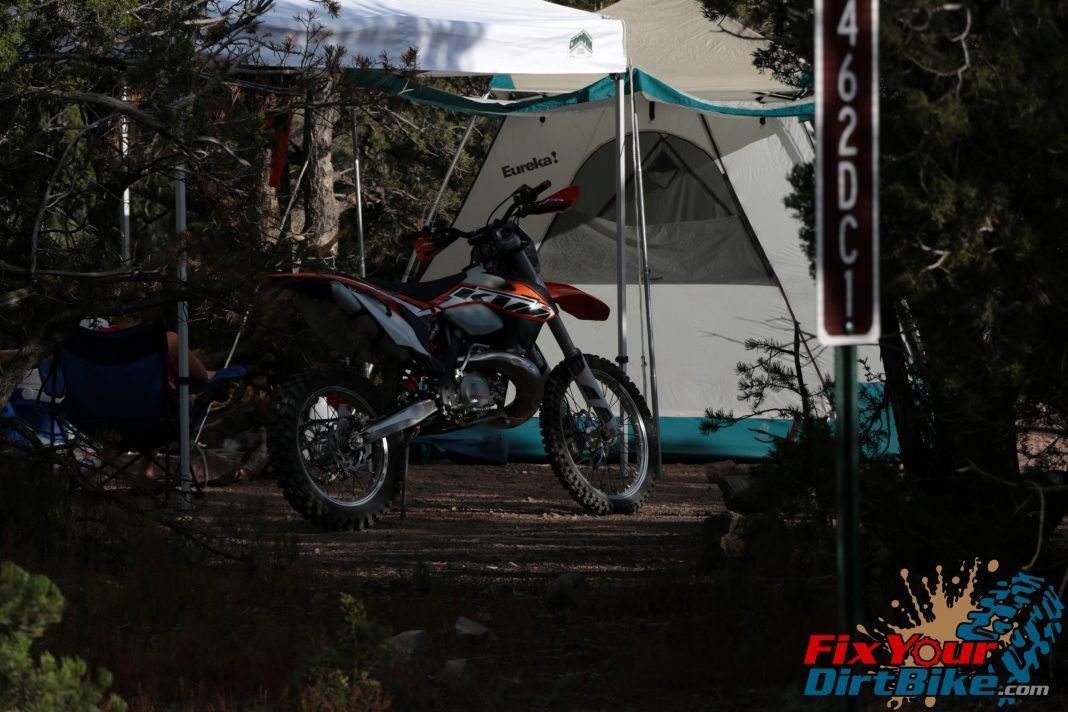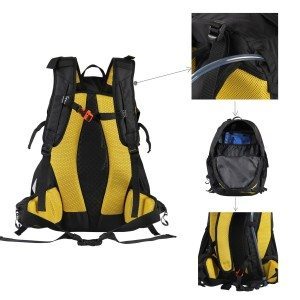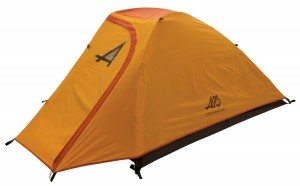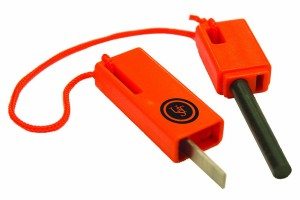The 12 Essential Items You’ll Need for Any Adventure Riding Trip
If I’m not messing around with things powered by explosions, then you’ll most likely find me camping out in the woods. For as long as I can remember, I’ve loved primitive camping – whether it be with friends, family, or by myself. And over the years, I’ve learned a lot of valuable lessons.
 But there’s one lesson that trumps them all, and that’s being prepared. Unfortunately, a lot of first-time primitive (not in an RV) campers learn the importance of being prepared the hard way. And that’s never a good time.
But there’s one lesson that trumps them all, and that’s being prepared. Unfortunately, a lot of first-time primitive (not in an RV) campers learn the importance of being prepared the hard way. And that’s never a good time.
So, in the spirit of fully embracing this “number one lesson” of primitive camping, I’ve made a list of the twelve essential gear and tools every primitive camper should bring with them – whether it’s their first or one-hundredth trip.
Basic Camping Gear
Backpacks. The first essential item is a backpack. The bags strapped to your dirt bike may not be able to hold everything, so your pack is what you’ll use to carry the rest of your items. It needs to be lightweight, durable, and, most importantly, not impede your riding motions. If there’s one piece of camping equipment in this list that you don’t want to skimp on, this is it.

A big hiking backpack is not going to work, as it will be too big and too top-heavy. A smaller, rigid frame backpack will suit your riding posture much better, especially if you are riding with a chest protector. If you can find a backpack with a built-in hydration pouch, even better!
Shelter. Your shelter will protect you from the elements, potential predators, and insects/pests. When shopping for a tent for camping, look for one that’s lightweight, waterproof, and not too big. For two people, a 4-person tent should give you plenty of space.
With tents, you REALLY get what you pay for. A $30 tent from Wall-Mart is going to be garbage. You might get two trips out of it before the sides start to tear, and the zippers break.
Related: Keep blister under control with prevention and first aid!
Match Quality to Quantity
Buy a tent that matches your frequency of use and how you are transporting it. If your tent is strapped to the back of your dirt bike, you don’t camp much, and you are camping in beautiful weather, a single person Wall-Mart tent might be the right one. As for me, I usually set up a base camp by my truck; this allows me to use my colossal aluminum pole tent my dad bought in the 80s. My dad bought his tent for $600, which for today’s dollar would be around $1,300. It’s still in great shape, and I use it frequently.
You Get What You Pay For With Camping Equipment!
Sleeping Bag. No tent is complete without a sleeping bag. The best sleeping bags will be durable, lightweight, comfortable, breathable, and warm. If you have the budget, invest in several sleeping bags that will suit your environment on different camping trips. There’s no point lugging around a -°40 sleeping bag in the summer. Fortunately, the lighter the sleeping bag, the cheaper it is!
Suitable Clothing. Wearing proper attire is just as important as having shelter. If you’re camping in southern Florida in the middle of summer, wear lightweight and breathable attire. If you’re in the mountains during winter, wear thermals, jackets, and plenty of layers. This is basic common sense, but what you need to be concerned with is the QUALITY of your attire. Jeans are an excellent go-to in most situations, but $150 American Apparel jeans won’t be nearly as useful as $20 Wranglers. If you have the budget, invest in some quality synthetic pants and jackets made explicitly for harsh environments.
If you are REALLY serious about riding in and camping, you can pick up a pair of cold weather dirt bike pants and a thermal jacket that cost way more money than I want to spend when a Carhartt Jacket will do the job.
Stay Fueled For Your Trip
Water. Water is your life source; so make sure you’re well supplied. The amount you’ll need will depend on the duration of your trip and the location of your site (whether a source of water is close by, or not). A good, general rule of thumb is to have at least 2 liters per day. If you don’t have a base camp for freshwater storage, add some water purification tablets to your camping equipment list. That stream may look clean and fresh, but there’s no way of knowing for sure, so why risk it?
Non-perishable Food. While you can pull a “Bear Grylls” and bite the heads off of tiny reptiles for a few measly calories, bringing enough food for your trip is usually a preferred and better option. Non-perishable meals like MREs and freeze-dried meals are great. Other options include canned goods, jerky, Clif bars, energy bars, dried fruits, etc.
A Pot. If you’re bringing food that has to be prepared, you need something to prepare that food in. A small, durable pot will be sufficient. Also, it can serve as a way to boil gathered water for sterilization. This would be for a base camp, as I have yet to find a pot that rides well strapped to my dirt bike.
Fire Starter. Fire is invaluable. It protects, heats, sterilizes, cooks, provides light, and so much more. So you want to all but guarantee your success at creating one. While it may be cool to use a bow drill, it’s not ideal. Matches, gas lighters, magnesium strikers, or other specialized strikers work best. And the more options you can carry, the better off you’ll be.
Stay Safe On The Trails
First Aid Kit. Never set off without a first aid kit. Accidents happen every day in the wilderness, even more so on a dirt bike, and you need to be prepared. There have been many instances where simple first aid kits have saved riders’ lives. You can create your own or purchase a preassembled one. Each kit should have Band-Aids, gauze pads, ace bandage, antibiotic (Neosporin), and an antihistamine (Benadryl).
Flashlights. A fire usually provides enough light for its immediate area, but if you need to wander away from it to “heed nature’s call” or for other purposes, another light source will serve you well. Packing a quality flashlight with a good light source and new batteries is never a bad idea. Even a small LED keychain light from the gas station if better than nothing.
Basic Camping Tools
Utility Knife. You’re never too old for a Swiss Army Knife, especially if you’re a primitive camper. Utility knives (or multi-tools) are invaluable. They serve an almost unlimited amount of useful purposes – from cutting and sawing to signaling for rescue.
Map and Compass. Your map will help keep you riding on the right path, and your compass will guide you if you happen to veer off of the right track (which happens more often than you think). If you’re camping in a park, the rangers will provide you with a map of the area. Grab two just in case you lose one. If you don’t have a GPS for your bike, I would highly recommend getting one.
Again, this is just a basic list of essentials to get started. If you can, always go camping with another person or an experienced camper!
If you have any questions or anything to add, please leave them in the comments or on our FaceBook page!



